Learn how to make a potato flake sourdough starter. Made with sugar, dehydrated potatoes, and yeast, you can make delicious sandwich bread with a much sweeter taste than its typical sourdough counterpart.
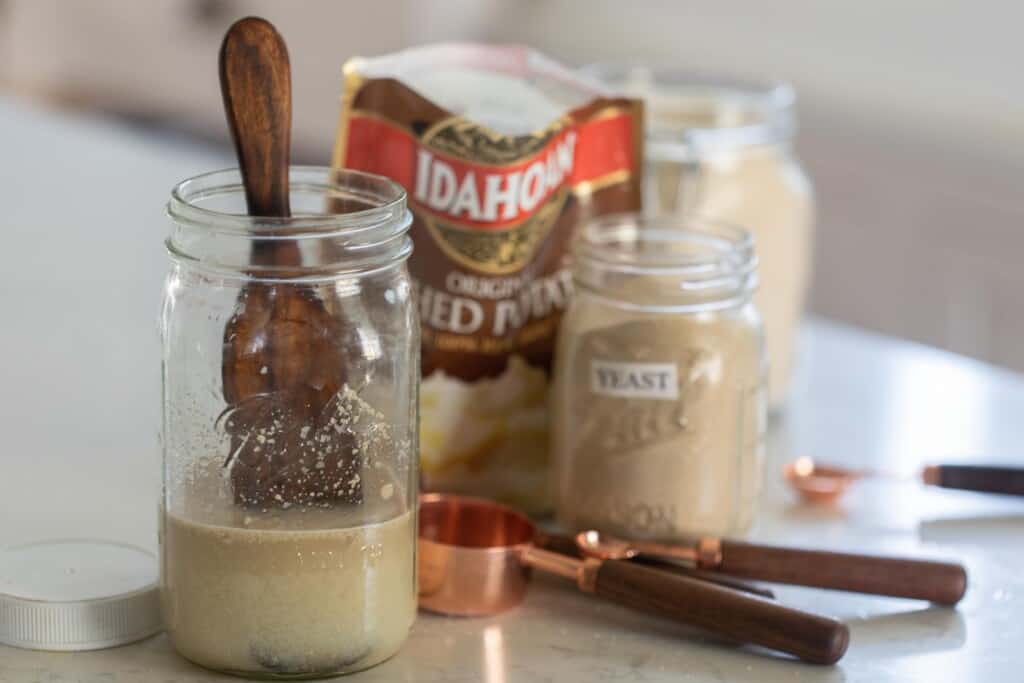
Table of Contents
- What is a potato flake sourdough starter?
- Why you’ll want a potato flake sourdough starter
- Tips for a sourdough bread starter with potato flakes
- FAQ
- Potato Flake Starter Ingredients
- How to make a potato flake sourdough starter
- How to maintain a potato flake sourdough starter
- Step-by-step instructions for maintaining your starter
- How to use your potato flake sourdough starter to make bread
- Directions:
- Check out more sourdough resources and recipes!
- Potato Flake Sourdough Starter Recipe
You know how much I love homemade sourdough bread. Sometimes, though, I do crave a sweeter bread with a little less of that signature sourdough tang and sourness.
I rarely make yeast breads. So, instead, I decided to make a potato flake starter recipe! This new starter is one of the traditional sourdough starter replacement methods.
Instead of a traditional San Francisco-style starter using flour and water, the potato flake version uses yeast, sugar, water, and dehydrated potatoes. That’s right — dehydrated potatoes!
This new starter is different from what some know as the Amish friendship bread starter (also known as southern style), although both typically use yeast to get started and include sugar.
The potato flake version gives bread a sweet taste. That’s why I love to use it on breads like sandwich bread, rolls, or even sweeter baked goods such as cinnamon rolls.
You can even use your potato flake starter discard in any of my discard recipes! This is perfect for anyone that isn’t sold on the sour in sourdough.
Today, I am going to share with you how I made my potato flake starter and how to properly care for and maintain it.
Plus, I’ve included a beginner bread recipe for you to try once your starter is ready to use! It is a take on my sourdough sandwich bread recipe with a few ingredient swaps and using potato flake starter instead of my regular starter.
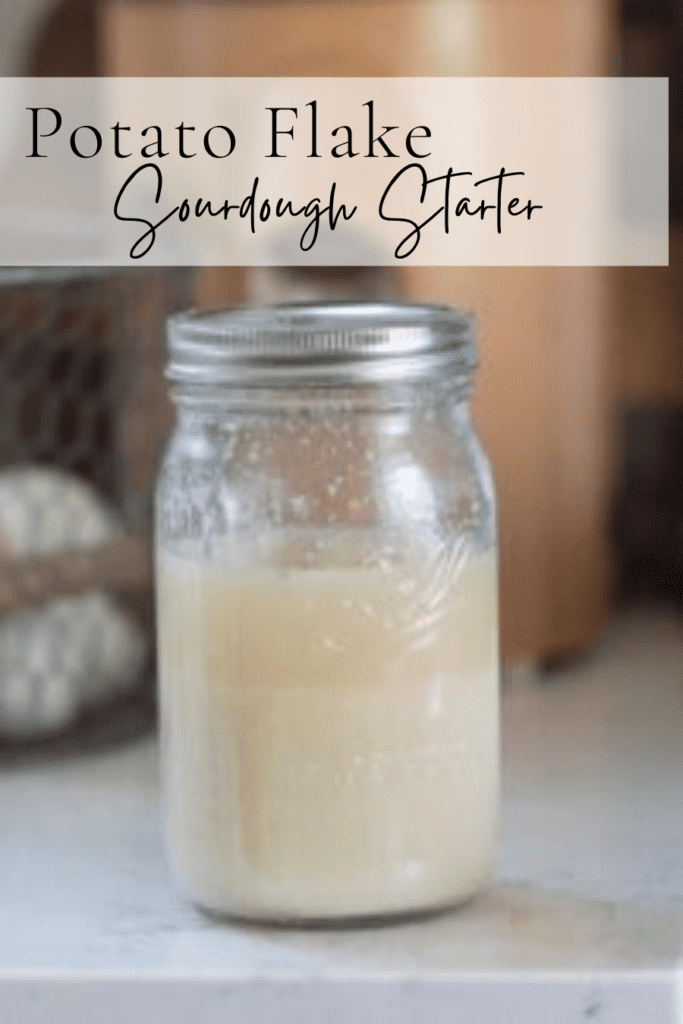
What is a potato flake sourdough starter?
A potato flake sourdough starter is made with dehydrated potato flakes, yeast, sugar, and water. When used in baking, it is what causes your bread to rise. It will give your baked goods a much sweeter taste than a traditional sourdough loaf. This starter is also gluten free and dairy free.
Note that not all yeast is gluten free. If you are strictly gluten free, you can reference this page to see what yeasts will work for you. A commercial yeast packet – active dry yeast or instant yeast – is typically considered gluten free.
This post contains affiliate links, which means I make a small commission at no extra cost to you. See my full disclosure here.
Why you’ll want a potato flake sourdough starter
A potato flake sourdough starter is fairly easy to maintain. Plus, this type of starter will result in a sweeter and less sour taste in your final product. I like it best in sandwich bread recipes or dinner rolls.
I’ve included a sourdough recipe below that is similar to my regular sandwich bread, but uses a potato flake starter instead!
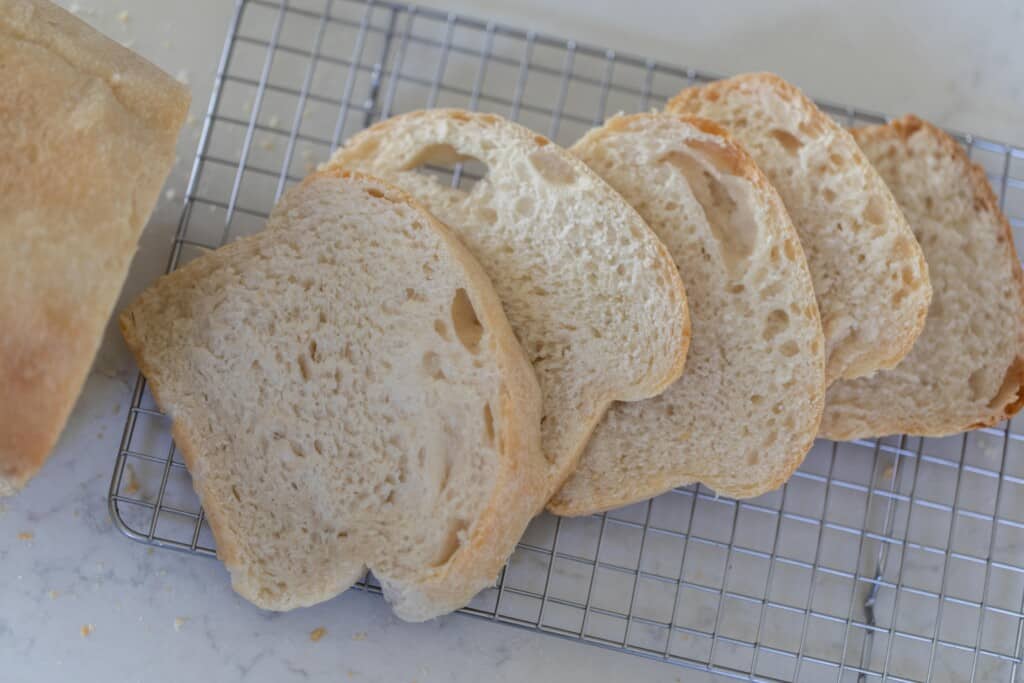
Tips for a sourdough bread starter with potato flakes
- Unlike your typical sourdough starter made with just flour and water, a potato flake starter will be a lot thinner. Of course, this will affect how much water you add to the recipe.
- If your potato flakes settle to the bottom – that is okay! It likely won’t stay incorporated, and that is normal. Simply give it a quick stir before use.
- Store your potato flake starter in the fridge. I try to feed it once a week to keep it thriving.
- If you do not want to make bread, you can discard one cup of the starter before feeding and use it in a sourdough discard recipe. My discard recipes call for traditional sourdough starter, but you can also use a potato flake starter instead. Check out some of those recipes here!
FAQ
A sourdough starter replaces the yeast in bread. It is the starter that allows bread to rise. Otherwise, your loaf would turn out flat and dense.
A traditional sourdough starter typically only uses flour and water to both create it and maintain it. A potato flake starter requires sugar, yeast, water, and potato flakes to get it started. To maintain it, you skip the yeast, but will still have to feed it sugar, water, and potato flakes! It tends to give breads a much sweeter taste than regular sourdough bread. If you’d like to learn how to make a traditional sourdough starter, click here!
It is sweeter and less sour.
Indefinitely, as long as you continue to maintain/feed it!
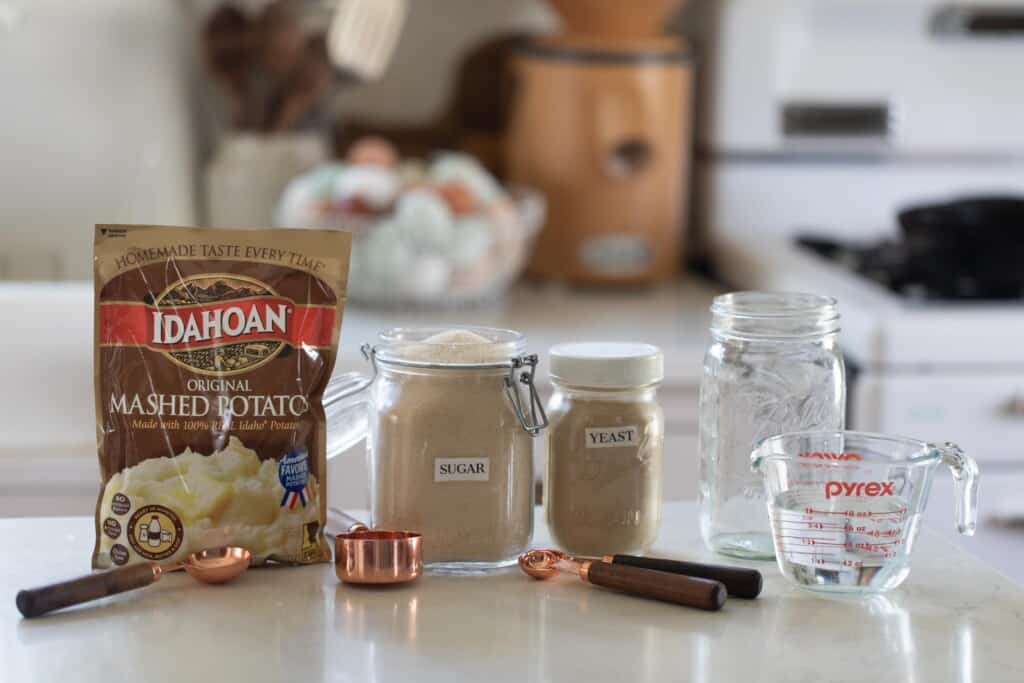
Potato Flake Starter Ingredients
This recipe will use potato flakes, sugar and commercial yeast to get it going. After it gets established, the wild yeasts will take over, and you will only have to feed it potato flakes, sugar and water.
1 cup warm water
1/4 cup sugar
1 package dry yeast (2 1/4 teaspoons)
3 tablespoons instant potato flakes
Tools to help you get started
Glass container/jar or large bowl
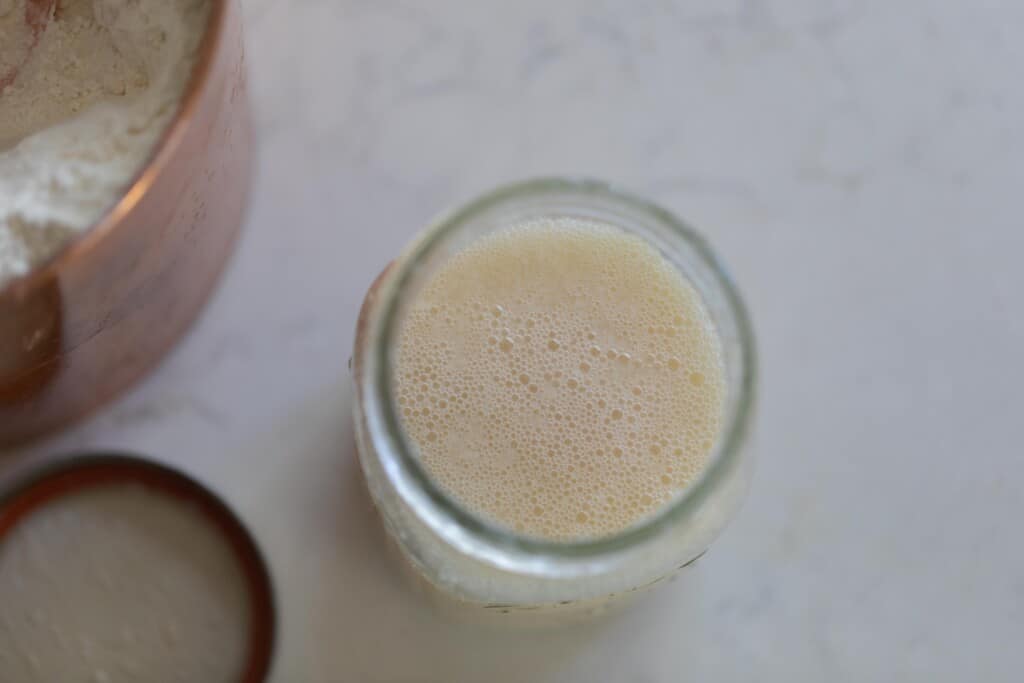
How to make a potato flake sourdough starter
- Start with a clean glass container or a large bowl.
- Add in the warm water, potato flakes, sugar and yeast.
- Stir everything together and scrape down the sides.
- Cover with something that is slightly breathable. You can use a tea towel or coffee filter with a rubber band. I like to use a flip top canister with the rubber gasket taken out or a glass jar with a glass lid. Both of these are not airtight, so the gasses (which are a natural bi product of fermentation) can escape.
- Leave it at room temperature for 4 days, stirring daily.
- On the 5th day, feed the starter with 1 cup warm water, 1/4 cup sugar and 3 tablespoons of instant potato flakes. Stir it well and allow it to sit at room temperature for 8 hours.
- Remove 1 cup of the starter to make your bread. Place the remaining starter in the refrigerator. (see instructions below to maintain for future use.)
How to maintain a potato flake sourdough starter
You maintain a potato flake sourdough starter a lot like you maintain a regular one, except you use different ingredients!
We used a package of commercial yeast to jumpstart this process originally, but you will not need it to maintain your starter.
Maintenance Ingredients
1 cup warm water
1/4 cup of sugar
3 tablespoons instant potato flakes
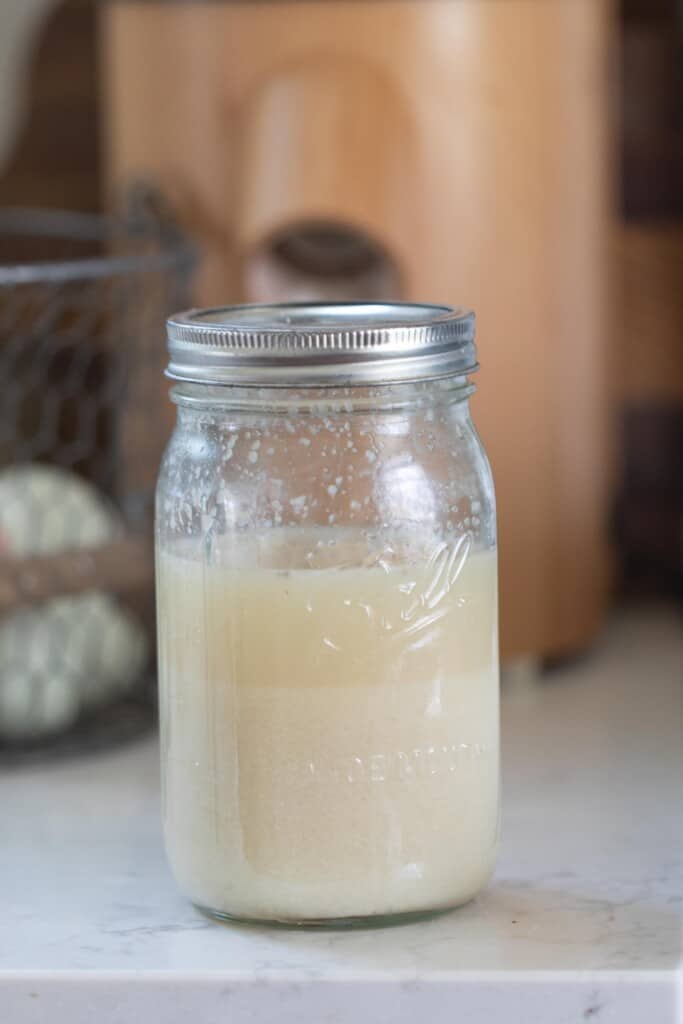
Step-by-step instructions for maintaining your starter
Remove your starter from the refrigerator, and feed it with 1 cup of warm water, 1/4 cup sugar and 3 tablespoons of instant potato flakes. Allow it to sit at room temperature for 6 hours, or until it looks bubbly and active.
Remove 1 cup of the starter to make potato flake sourdough starter bread. Put it back in the refrigerator until you want to repeat this process and make another loaf of bread.
Storing your potato flake starter in the refrigerator
Just like with a regular sourdough starter, you can store it in the refrigerator for several weeks in between uses, but it stays most active if you feed it regularly. Aim for once a week.
If you do not want to make bread, you can discard one cup of the starter before feeding and use it in a sourdough discard recipe. My discard recipes call for traditional sourdough starter, but you can also use a potato flake starter instead. Check out some sourdough discard recipes here.
How to use your potato flake sourdough starter to make bread
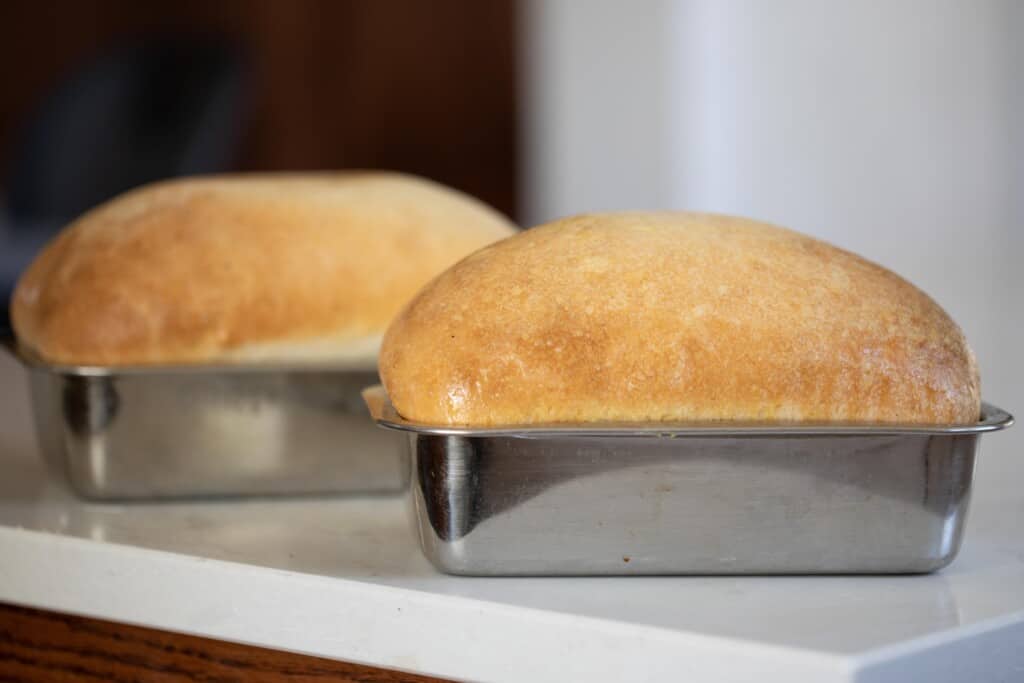
Ingredients
1/2 cup butter (softened) or coconut oil (113 g)– Use coconut oil if you are making this dairy-free or simply like more of a coconut taste.
1/2 cup sugar (96 grams)
1 tbs salt (17 grams) – I use a tablespoon salt, and prefer to use sea salt if possible!
1 cup potato flake sourdough starter (275 g), active and bubbly, active and bubbly
2 1/4 cups water (531 g)
8 cups all purpose flour (1200 g)
Tools you may need
Measuring cups and spoons (or a kitchen scale)
9.5 in by 5 in Loaf pans
Directions:
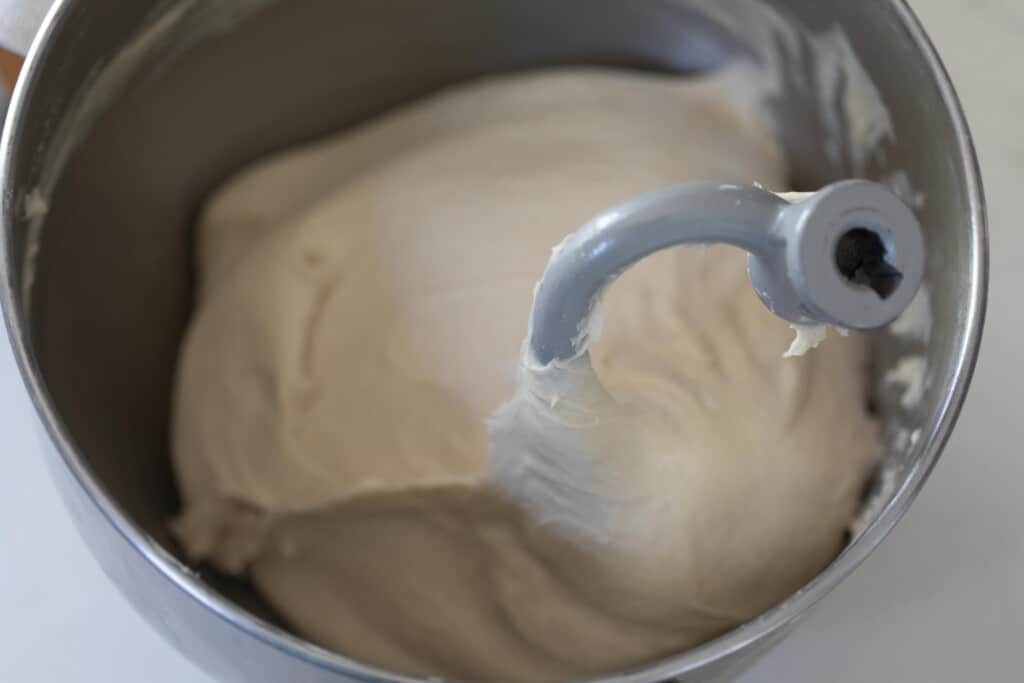
Mix ingredients
Add all of the ingredients to a stand mixer. I recommend adding the flour last. This way you can add more or less as needed, pending your starters hydration level.
Knead the dough
Turn on your stand mixer and knead the dough until it is stretchy and smooth. It will take about 10 minutes. When it is ready, it will pull away from the sides of the bowl and be elastic and smooth.
Make sure it passes the windowpane test! Grab a small ball of the dough and stretch it into a square. It should stretch thin enough to see through without breaking.
Bulk Rise
In a warm place, allow your dough ball to bulk rise for 10-12 hours. You can go longer if you want the benefit of the fermentation. However, don’t overproof! It will turn your dough into a sloppy mess.
Shape and rise
Prepare two loaf pans by either greasing them or adding pieces of parchment paper.
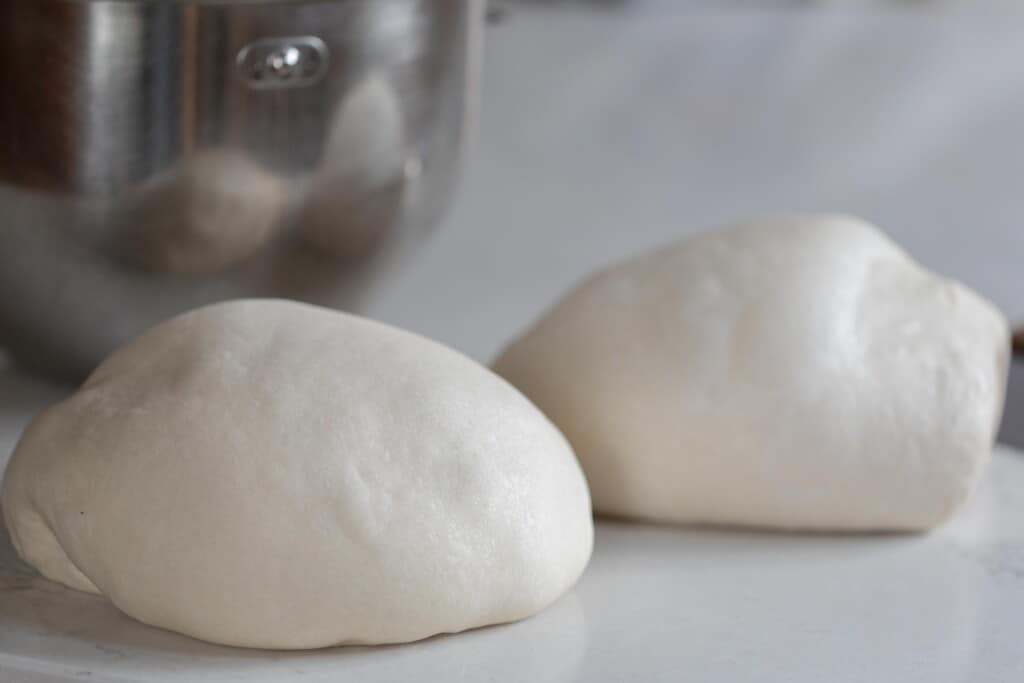
Divide dough into two equal parts.
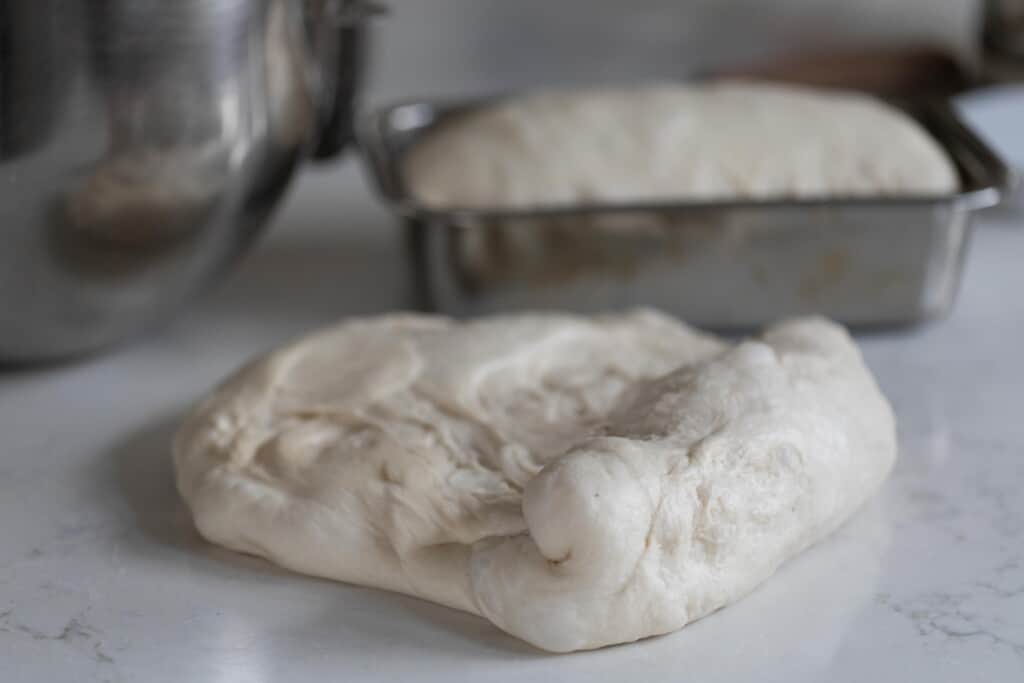
To shape your dough, roll it out flat into a rectangle and then roll it up.
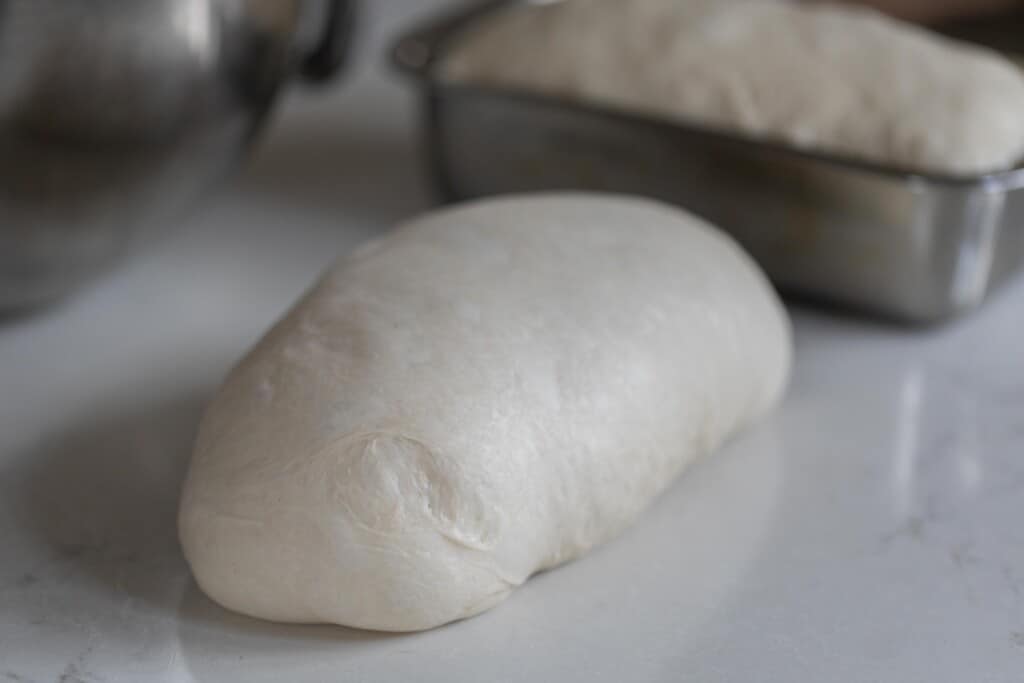
Allow to rise again for 2- 4 hours at room temperature or until doubled. The amount of time all depends on the temperature of your home.
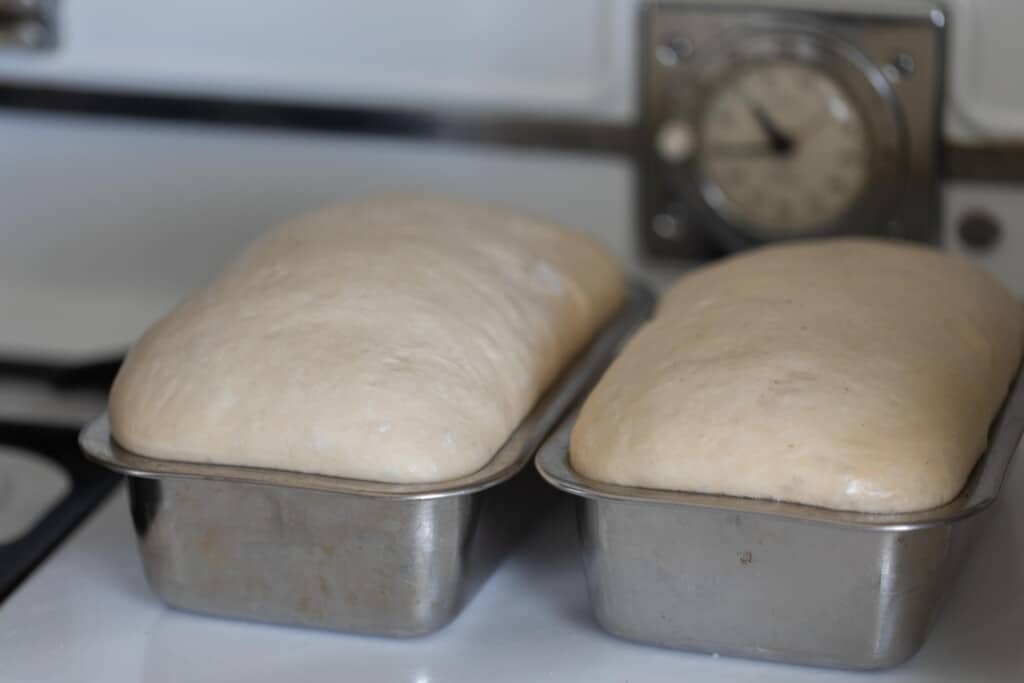
Bake
Optional: Add an egg wash on top of the loaves before baking. This provides more browning.
Bake at 375 for 45 minutes, or until golden on top.
Allow to cool completely before slicing.
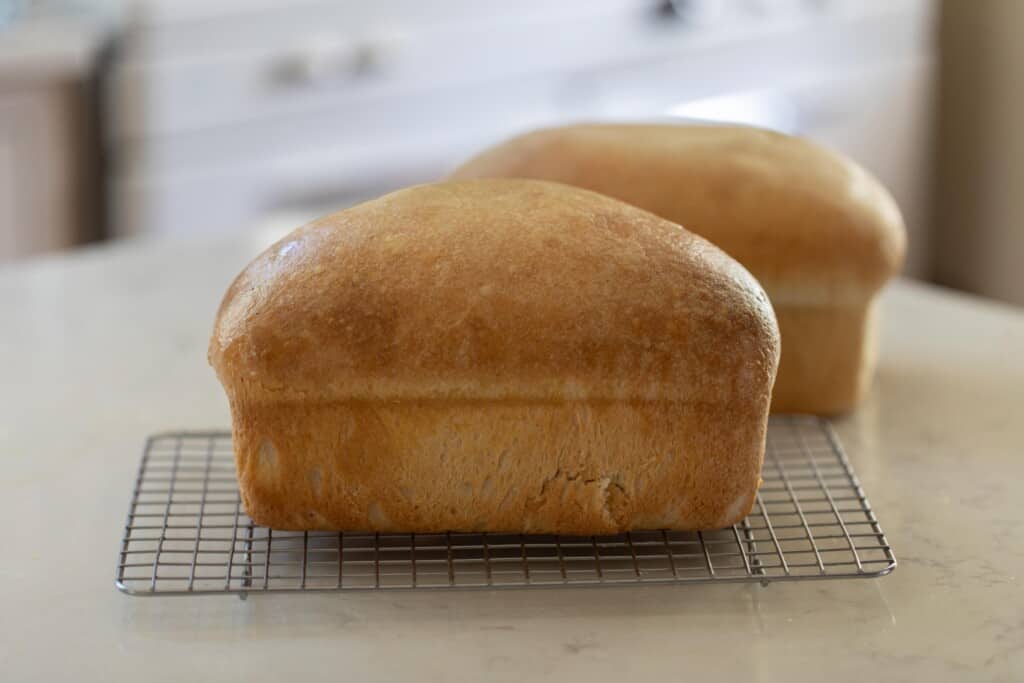
Check out more sourdough resources and recipes!
- Learn how to make a traditional sourdough starter
- How to maintain a traditional sourdough starter
- Gluten Free Sourdough Starter
- Sourdough Cinnamon Rolls
- Sourdough Dinner Rolls
If you try this recipe and love it, I would love it if you gave it 5 stars! Thank you! Tag me on Instagram @farmhouseonboone.
Potato Flake Sourdough Starter
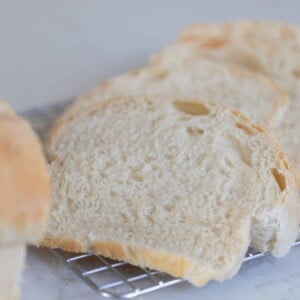
Ingredients
- 1 cup warm water
- 1/4 cup sugar
- 1 package dry yeast, 2 1/4 teaspoons
- 3 tablespoons instant potato flakes
Instructions
- Start with a clean glass container or a large bowl.
- Add in the warm water, potato flakes, sugar and yeast.
- Stir everything together and scrape down the sides.
- Cover with something that is slightly breathable. You can use a tea towel or coffee filter with a rubber band. I like to use a flip top canister with the rubber gasket taken out or a glass jar with a glass lid.
- Both of these are not airtight, so the gasses (which are a natural bi product of fermentation) can escape.
- Leave it at room temperature for 4 days, stirring daily.
- On the 5th day, feed the starter with 1 cup warm water, 1/4 cup sugar and 3 tablespoons of instant potato flakes. Stir it well and allow it to sit at room temperature for 8 hours.
- Remove 1 cup of the starter to make your bread. Place the remaining starter in the refrigerator.
Maintaining The Starter
- Remove your starter from the refrigerator, and feed it with 1 cup of warm water, 1/4 cup sugar and 3 tablespoons of instant potato flakes.
- Allow it to sit at room temperature for 6 hours, or until it looks bubbly and active.
- Once bubbly, it can be used in bread recipes.
- Keep stored in the fridge between uses. Feed every 3-5 days
Notes
Nutrition
Nutrition information is automatically calculated, so should only be used as an approximation.










Ok so I messed up and did 1/2 a cup of sugar to make the starter, but used all the correct amounts of the other ingredients. Can I still move forward by feeding only 1/4 cup sugar or will it messed up or do I need to continue to feed it 1/2 a cup each feed? I’ve made it before and it was great but life got busy and I went toooooo long without feeding my starter.
Yes, just discard a little bit more the next day.
Hi! I made my first loaves of breading using this type of starter (it was given to me), my question is, one making makes 2 loaves, if I wanted to make lots of loaves (like 10 or more) how would I increase the quantity of starter to make that much? Not bake for a few weeks and keep taking a cup and feeding it separately?
No. Just before you go to make your recipe, feed your starter in abundance!
Hi Lisa, I love your site. I made this bread last night and it looks beautiful this morning. It rose beautiful. I have a question about the windowpane test. I never could get it to that point and it was very sticky with the 8 cups of flour I had added. Does it need kneading more to pass the test and do I need to add more flour for the stickiness? Thank you!
More kneading can help, as well as letting the dough rest for around 30 minutes or so and then coming back to it. If that doesn’t work, sometimes more flour is needed.
Thank you! It turned out great and tasted so good.
I haven’t tried your recipe yet but I already have my potato sourdough starter going because it is one of my favorite breads from growing up. My neighbor used to make it and give us a fresh loaf warm from the oven. It was divine! But she would never share the recipe!!
During confinement a friend from childhood said her mom made a special sourdough and it turned out to be this potato flake dough. It was so hard to find yeast during lockdown that I used a couple tablespoons of my regular sourdough starter to boost my potato starter and it worked perfectly! So you don’t necessarily need yeast, just some active starter 🙂
How should I store my starter in the fridge? Should I keep it airtight like in a mason jar or does it still need to be slightly “breathable?”
Air tight jar in the fridge.
Good morning
What did I do wrong
I used a quart jar with coffee filter and rubber band mixed the sourdough up last night It was working great, this morning the coffee filter and rubber band wasn’t on the jar and the sourdough mix had stop working??????
How long have you been feeding it? It needs to be fed for awhile before it becomes active.
Do you use bread flour?
You can!
my starter keeps not rising only one of my starters will I have three other that don’t do well I follow the recipe and I’ve put 1 1/4 teaspoon if yeast in one and im about to feed it. is it okay to but yeast in them or not.
When I start this starter I always let it sit on my counter covered with a drk towel, for 5-7 days befor I feed it again. By doing this it helps it ferment better. Then I use a dish cloth and a rubber band over the top and place in the frig after I use my cup for baking.
Make sure you are not using anything metal in your starter and dough. Buy using wook, glass, or plastic it will keep your starter going or a long time. My starter is 50 years old this year. My grand mother made it. If you split off a 1.5c to give away a starter, make sure to leave it on the counter for 5-7 days then feed it again. After using or discarding a cup then it can go in the frig.
I’m very excited, I’ve been trying to figure out my German grandmother’s recipes, none of which were written down of course, and just going off of what my father describes can be hard. But this sounds like her starter. He said she called it Everlasting Yeast and it used potatoes. Now she did not keep it in the fridge, hers was in a very cool cold cellar. I’ve asked him for further information but even the sandwich bread you describe sounds like hers. It always had a unique texture. Light and fluffy but not at all like store bought. Thank you so much for this starter recipe! My sister and I were lamenting that we may never get to have her potatoes and dumplings again since no one knew how to make them without her starter!
Ok to use king Arthur bread flour, or better to use All Purpose flour?
Yes, that’s fine!